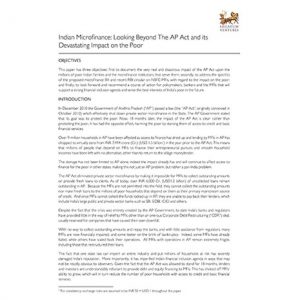Indian Microfinance: Looking Beyond The AP Act and its Devastating Impact on the Poor

In December 2010 the Government of Andhra Pradesh (“AP”) passed a law (the “AP Act”, originally conceived in October 2010) which effectively shut down private sector microfinance in the State. The AP Government stated that its goal was to protect the poor. Now, 18 months later, the impact of the AP Act is clear: rather than protecting the poor, it has had the opposite effect, harming the poor by starving them of access to credit and basic financial services.
Over 9 million households in AP have been affected as access to finance has dried up and lending by MFIs in AP has dropped to virtually zero from INR 7,494 crore (Cr.) (USD 1.5 billion1) in the year prior to the AP Act. This means that millions of people that depend on MFIs to finance their entrepreneurial pursuits and smooth household incomes have been left with no alternative, other than to return to the village moneylender.
The damage has not been limited to AP alone; indeed the impact already has and will continue to affect access to finance for the poor in other states, making this not just an AP problem, but rather a pan-India problem.
The AP Act eliminated private sector microfinance by making it impossible for MFIs to collect outstanding amounts or provide fresh loans to clients. As of today, over INR 6,000 Cr. (USD1.2 billion) of uncollected loans remain outstanding in AP. Because the MFIs are not permitted into the field, they cannot collect the outstanding amounts nor make fresh loans to the millions of poor households that depend on them as their primary mainstream source of credit. And since MFIs cannot collect the funds locked up in AP, they are unable to pay back their lenders, which include India’s large public and private sector banks such as SBI, SIDBI, ICICI and others.




